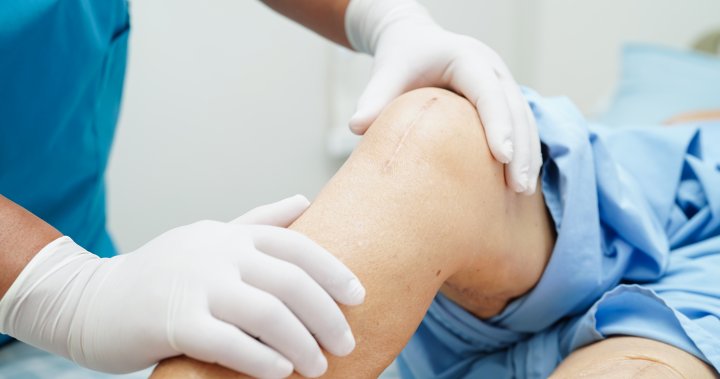About one in three Canadians needing a new hip or knee are waiting longer than they should, but instead of turning to private clinics, researchers say a more centralized referral system could help fix the backlog.
A study published Tuesday in the Canadian Medical Association Journal (CMAJ) found that organizing referrals and surgeries through a coordinated, team-based approach could help with long wait times for hip and knee replacements.
“Canada performs poorly for access to scheduled surgery … access to care is a weakness in the Canadian health system, this has really been the Achilles heel of the Canadian health system,” said Dr. David Urbich, study author and head of the department of surgery at Women’s College Hospital in Toronto.
“But the good news is, there are very good solutions. They’re not difficult. They are not expensive.”
Reducing wait times for hip and knee replacement surgeries could be as simple as reorganizing how patients are referred to surgeons — no need for extra operating rooms, more surgeons or additional funding, the study argued.
In Canada, the benchmark wait time for hip and knee replacement surgery is 182 days — six months.
According to the latest data from the Canadian Institute for Health Information, around 66 per cent of patients get their surgery within that window. But that still leaves a third waiting longer.
The numbers are even lower for knee replacements, with just 59 per cent getting the procedure within six months.

Get weekly health news
Receive the latest medical news and health information delivered to you every Sunday.
To address this issue, some Canadian provinces have been experimenting with private for-profit delivery of some surgeries to help ease wait times.
However, this study proposes creating a central list, saying it could impact wait times more effectively.
For many Canadians, the process of getting a knee or hip surgery starts with a “direct physician-to-physician referral,” Urbich explained.
That means a family doctor refers the patient to a specialist — but they might not know if it’s the right one or even the next available one.
Most surgeons work as independent practitioners, managing their own waitlists for consultations and surgeries. Once a surgeon takes on a patient for a procedure, they typically don’t share care with other surgeons, according to the study.
To see if there’s a better way to tackle long wait times, the researchers looked into a few different intake models aimed at helping patients get seen faster.
Using data from Ontario, they broke things down into three models of care.
The study focused on patients referred by a family doctor or general practitioner in 2017 for non-urgent hip or knee replacements. In total, the simulations were based on 17,465 surgeries performed on 17,132 patients, involving 7,783 referring doctors, 274 surgeons and 71 hospitals across five regions in Ontario.
The models included:
- Single-entry referral model. This is when all patients’ referrals in a region are pooled together and then directed to the next available surgeon for consultation, rather than being sent to specific surgeons individually.
- Team-based care model. After consultation, patients who need surgery enter a shared regional queue and are scheduled for surgery on the next available date with any surgeon in that region, instead of waiting for a specific surgeon.
- Fully integrated model. This combines both the single-entry referral and team-based care models. Patients are pooled into a single queue both for consultations and surgeries, and they see the next available surgeon for each step.
Both team-based and fully integrated models had much larger effects on reducing wait times than the single-entry referral model, the study found.
“The best model is when surgeons work together in teams and share the care of patients together and patients are referred to a team,” Urbich said.
“So they’re seen by the next available surgeon for consultation. And then when it comes time to have surgery, they also have surgery by the next available surgeon.”
That is what it takes to prevent anybody from waiting too long for a joint replacement surgery, he added.
He also stressed that in these models, all surgeons are qualified and experts in the operations they do.
“Adoption of these models will require strong leadership among health-system leaders and the active participation of surgeons,” the study concluded. “It will also require some investment in system infrastructure, instead of one-time investments to increase surgical volumes during times of crisis.”
© 2025 Global News, a division of Corus Entertainment Inc.
Read the full article here
